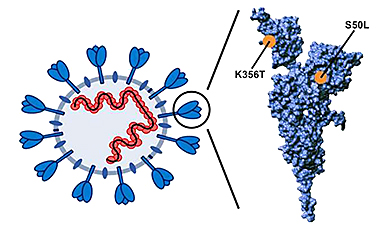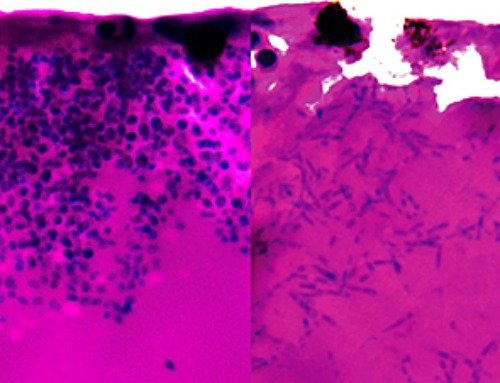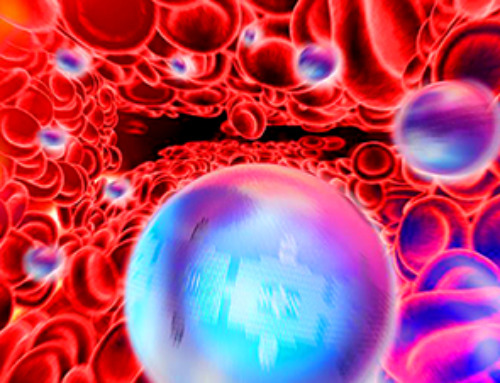Despite the end of the pandemic, COVID-19 continues to pose a serious health threat. Most individuals have established robust immune protection and do not develop severe disease but the infection can still lead to marked and sometimes long-lasting disease symptoms.
The researchers discovered that the pirola variant, in contrast the all previously circulating omicron variants, enters lung cells with high efficiency and uses the cellular enzyme TMPRss2 for entry, thereby exhibiting surprising parallels to variants alpha, beta, gamma and delta that circulated during the first years of the pandemic. The improved entry into lung cells might indicate that the virus is more aggressive but production of new, infectious viral particles in infected cells was reduced, which may limit spread and pathogenic potential.
The researchers report in the journal Cell that the pirola variant is resistant against all therapeutic antibodies and efficiently evades antibody responses in vaccinated individuals with and without breakthrough infection. However, the virus was appreciably inhibited by antibodies elicited by the new, XBB.1.5-adpated mRNA vaccine.
In summary, the results show that four years after the start of the pandemic the virus is still capable of profound changes and can reacquire properties that may promote the development of severe disease.
The spread of SARS-CoV-2 is associated with the constant emergence of new viral variants. These variants have acquired mutations in the spike protein, which allow evasion of neutralizing antibodies in vaccinated and convalescent individuals. The emergence of viral variants started with the alpha variant followed by the beta, gamma and delta variants.
At the end of the year 2021 the omicron variant became globally dominant, which, based on genome sequence, differed markedly from previously circulating variants. However, the virus had to pay a price for this massive change. Thus, the omicron variant evades neutralizing antibodies and is transmitted with high efficiency but has lost the ability to efficiently use a host cell enzyme, the protease TMPRSS2, for lung cell entry. As a consequence, the omicron variant induces pneumonia less frequently.
Pirola: A quantum leap in SARS-CoV-2 evolution
Descendants of the omicron variant dominated globally until the end of the year 2023. New variants frequently differed only by few mutations from their predecessors and there was evidence that viruses circulating in 2023 had only limited options to evade antibody pressure in the human population. Therefore, the discovery of a new SARS-CoV-2 omicron subvariant, pirola (BA.2.86), which, based on genome sequence, strongly differed from other circulating viruses drew a lot of attention.
The pirola variant, analogous to the omicron variant, likely arose in immunocompromised patients and presents a quantum leap in SARS-CoV-2 evolution. The spike protein of the pirola variant harbors more than 30 mutations relative to its precursor variant, BA.2, and it is largely unknown how these mutations affect the biological properties of the virus.
A team of researchers from the German Primate Center (DPZ) led by Markus Hoffmann and Stefan Pöhlmann addressed this question jointly with the research groups of Christian Drosten (Charité, Berlin), Georg Behrens (Hannover Medical School), Luka Cicin-Sain (Helmholtz Center for Infection Research, Braunschweig) and Hans-Martin Jäck (Friedrich-Alexander-University Erlangen Nuremberg).
Pirola can infect lung cells more efficiently
The researchers discovered that the pirola variant, in contrast to all previously circulating omicron subvariants, enters lung cells with high efficiency and in a TMPRSS2-dependent manner. Further, they could demonstrate that mutations S50L and K356T in the spike protein of the pirola variant are important for the highly efficient lung cell entry.
“It is noteworthy that two years after the global dominance of the omicron variant, which fails to robustly enter lung cells, now a quite different virus is spreading and that this virus is able to again enter lung cells with high efficiency. If the augmented lung cell entry translates into more severe disease upon infection with the pirola variant remains to be investigated in animal models,” says Pöhlmann, head of the Infection Biology Unity of the German Primate Center.
Pirola replicates less well than its predecessors
SARS-CoV-2 infected cells produce new virus particles many of which, but not all, are able to infect new cells. The researchers provided evidence that cells infected by the pirola variant are less well able than cells infected with previous variants to produce intact viral particles. “The relatively inefficient production of infectious particles by cells infected with the pirola variant was surprising,” says Hoffmann, the lead contact of the study.
“It will be interesting to analyze which mechanism is responsible. Maybe the infected cells produce defective interfering particles, which regulate spread of the pirola variant and contribute to antibody evasion.”
Therapeutic antibodies are ineffective against pirola
Recombinantly produced neutralizing antibodies were successfully used for COVID-19 prophylaxis and therapy. However, due to the emergence of viral variants with mutations in the antibody binding sites most of those antibodies are not active against currently circulating variants. The present study shows that the pirola variant is no exception—none of the tested antibodies was able to neutralize the virus.
“These results show that the development of new, broad spectrum antibodies is an important task,” says Hoffmann.
New, adapted vaccine protects against pirola
The pirola variant was also able to evade antibodies induced by vaccination or infection but with less efficiency than the contemporaneously circulating Eris variant (EG.5.1). However, antibodies induced by vaccination with the new XBB.1.5-adapted vaccine were able to appreciably inhibit both the pirola and the Eris variant.
“These results suggest that the XBB.1.5-adpated vaccine might induce a robust, although likely short-lived, protection against infection with the pirola variant,” says Hoffmann.
“In this context it is interesting that subvariants of pirola are currently globally on the rise that harbor an additional mutation in the spike protein, which may increase antibody evasion. The virus is in the process of optimizing itself and the consequences of this optimization should be studied,” adds Lu Zhang, first author of the study.
More information: Lu Zhang et al, SARS-CoV-2 BA.2.86 enters lung cells and evades neutralizing antibodies with high efficiency, Cell (2024). DOI: 10.1016/j.cell.2023.12.025
News
AI Helped Scientists Stop a Virus With One Tiny Change
Using AI, researchers identified one tiny molecular interaction that viruses need to infect cells. Disrupting it stopped the virus before infection could begin. Washington State University scientists have uncovered a method to interfere with a key [...]
Deadly Hospital Fungus May Finally Have a Weakness
A deadly, drug-resistant hospital fungus may finally have a weakness—and scientists think they’ve found it. Researchers have identified a genetic process that could open the door to new treatments for a dangerous fungal infection [...]
Fever-Proof Bird Flu Variant Could Fuel the Next Pandemic
Bird flu viruses present a significant risk to humans because they can continue replicating at temperatures higher than a typical fever. Fever is one of the body’s main tools for slowing or stopping viral [...]
What could the future of nanoscience look like?
Society has a lot to thank for nanoscience. From improved health monitoring to reducing the size of electronics, scientists’ ability to delve deeper and better understand chemistry at the nanoscale has opened up numerous [...]
Scientists Melt Cancer’s Hidden “Power Hubs” and Stop Tumor Growth
Researchers discovered that in a rare kidney cancer, RNA builds droplet-like hubs that act as growth control centers inside tumor cells. By engineering a molecular switch to dissolve these hubs, they were able to halt cancer [...]
Platelet-inspired nanoparticles could improve treatment of inflammatory diseases
Scientists have developed platelet-inspired nanoparticles that deliver anti-inflammatory drugs directly to brain-computer interface implants, doubling their effectiveness. Scientists have found a way to improve the performance of brain-computer interface (BCI) electrodes by delivering anti-inflammatory drugs directly [...]
After 150 years, a new chapter in cancer therapy is finally beginning
For decades, researchers have been looking for ways to destroy cancer cells in a targeted manner without further weakening the body. But for many patients whose immune system is severely impaired by chemotherapy or radiation, [...]
Older chemical libraries show promise for fighting resistant strains of COVID-19 virus
SARS‑CoV‑2, the virus that causes COVID-19, continues to mutate, with some newer strains becoming less responsive to current antiviral treatments like Paxlovid. Now, University of California San Diego scientists and an international team of [...]
Lower doses of immunotherapy for skin cancer give better results, study suggests
According to a new study, lower doses of approved immunotherapy for malignant melanoma can give better results against tumors, while reducing side effects. This is reported by researchers at Karolinska Institutet in the Journal of the National [...]
Researchers highlight five pathways through which microplastics can harm the brain
Microplastics could be fueling neurodegenerative diseases like Alzheimer's and Parkinson's, with a new study highlighting five ways microplastics can trigger inflammation and damage in the brain. More than 57 million people live with dementia, [...]
Tiny Metal Nanodots Obliterate Cancer Cells While Largely Sparing Healthy Tissue
Scientists have developed tiny metal-oxide particles that push cancer cells past their stress limits while sparing healthy tissue. An international team led by RMIT University has developed tiny particles called nanodots, crafted from a metallic compound, [...]
Gold Nanoclusters Could Supercharge Quantum Computers
Researchers found that gold “super atoms” can behave like the atoms in top-tier quantum systems—only far easier to scale. These tiny clusters can be customized at the molecular level, offering a powerful, tunable foundation [...]
A single shot of HPV vaccine may be enough to fight cervical cancer, study finds
WASHINGTON -- A single HPV vaccination appears just as effective as two doses at preventing the viral infection that causes cervical cancer, researchers reported Wednesday. HPV, or human papillomavirus, is very common and spread [...]
New technique overcomes technological barrier in 3D brain imaging
Scientists at the Swiss Light Source SLS have succeeded in mapping a piece of brain tissue in 3D at unprecedented resolution using X-rays, non-destructively. The breakthrough overcomes a long-standing technological barrier that had limited [...]
Scientists Uncover Hidden Blood Pattern in Long COVID
Researchers found persistent microclot and NET structures in Long COVID blood that may explain long-lasting symptoms. Researchers examining Long COVID have identified a structural connection between circulating microclots and neutrophil extracellular traps (NETs). The [...]
This Cellular Trick Helps Cancer Spread, but Could Also Stop It
Groups of normal cbiells can sense far into their surroundings, helping explain cancer cell migration. Understanding this ability could lead to new ways to limit tumor spread. The tale of the princess and the [...]





















